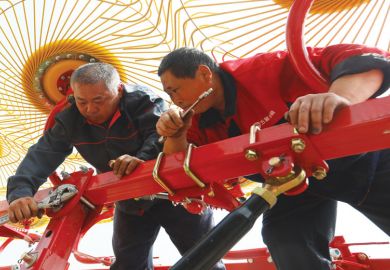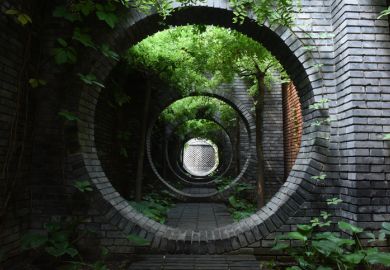It is not possible to do justice to the breadth and quality of the Architecture Research Quarterly ( arq ) in the space available. Instead, let us focus on the intentions of the founders as stated in the first issue: to publish the best architectural research, whether by academics or the profession, which reveals "an integrating, value-laden, holistic, design-related, user-responsive, inventive and entirely distinctive mode of thought".
Editor Peter Carolin's first leader in 1995 betrayed an inferiority complex about architectural research that he and his referees have proved unfounded ever since. They did not want arq to become a vehicle for academics to gain points in research ratings. Their view is that government and academic administrators do not seem to appreciate the difference between a practical profession such as architecture and the pure sciences governed by massive international research programmes, and accordingly have restricted funding for architectural training. Hence, the Architects Registration Board's concern about the allegedly woeful lack of technical teaching and the imminent threat to five schools of architecture. Or is the cause the separation of practice from education that benefits neither working architects nor academics, and that this magazine aims to bridge?
According to Francis Duffy, in the past the strength of the technical press in the UK inhibited the emergence of more weighty journals. However, the trend towards generalisation, sensationalism and more illustration, especially in colour, has left a gap in the market that arq aims to fill. Peter Blundell-Jones believes that the clarity that the media demands creates an architecture with few clear gestures. Thus, buildings needing deep study to reveal themselves are at a disadvantage. He thinks this attitude existed in the 1960s when the work of Alvar Aalto and Hans Scharoun was not taken seriously. He thinks that this mistake has now been recognised.
Unfortunately, arq 's limited budget does not allow colour illustration, and the quality of the black-and-white illustrations is often muddy. This reduces the understanding of good architecture, in which colour and texture are of the essence. For example, Neil McLaughlin's vivid description of his competition entry for the Turner Centre in Margate is visually an anti-climax. His colour Cad images are reproduced as a grey sludge. Where is the vivid blue of the sea contrasting with the white chalk walls? As for drawings, the obsessive consistency of the monthly journals Detail and GA may be the right benchmarks for production drawings, but they are not necessarily so for a journal of more general interest. However, arq is refreshingly varied in the style and scale of its drawings. The quality of line, weight and tone is well judged, matching that achieved by Architecture Today , although the range of the latter's style is more limited.
Arq 's articles are diverse, ranging from Patrick Hodgkinson's direct nuggets (his tartan grid for a factory in Hitchin in 1960 was executed by Arup's, which later claimed to have invented it); through Peter Smithson's Spartan prose (a description of his return to Hunstanton School) with gaps in his descriptions matching the polite mannerisms of his speech; to Sam Price's eloquent explanation of cantilevered staircases.
Tomes published on prominent practices' latest projects often lack critical appraisal, so it is good to see that arq has not flinched from this. Michael Spens receives criticism for his analysis of Leslie Martin's Cornford House in Cambridge, and his reassessment of James Stirling's work. The letters column has developed into a lively component of the journal, extending regularly to nearly 10 per cent of the content.
What criteria should be used to judge arq 's editorial success? The structure of topics has remained remarkably consistent since the first issue in 1995. Some are self-explanatory, such as history, theory, environment, information technology, construction, practice and book reviews. Others, such as "Documents", include primary sources of historical interest and importance, for example by E. G. Asplund on "Our architectural conception of space" or Steven Spier's rare interview with Peter Zumthor. Within this structure, contributions come from academics as well as by practising architects, engineers and planners, with the editors consciously trying to avoid "compartmentalisation of architectural research".
The breadth of topics has been maintained so as to appeal to a wide readership. Many are the product of long research efforts (for instance, André Potvin's investigation of the environments of arcades). Will arq regain the esteem accorded to The Builder and The Building News in the 19th century as magazines of record, debate and campaigning; and to The Architectural Review in the 1940s and 1950s for its coverage of design, urbanism and history? Arq 's quarterly appearance rules out ephemeral reporting, but the length and depth of articles, and the topicality of some, such as Ove Arup's on the education of architects, shows arq 's serious aspiration. It is more valid to compare arq with specialist journals produced by the five statutory amenity societies, as well as the Newcomen Society, the scholarship of which is always a treat within their more narrow confines.
But are practising architects reading arq , let alone raising their game intellectually and practically in response? The Royal Institute of British Architects' requirements for "continuing professional development" are mandatory for its members. Would the reading of arq prove an efficient tool for maintaining skill levels? Although at least 15 magazines arrive on my desk each week, I think a practitioner should find time to read arq . But the journal must maintain its distinction from the existing weeklies and monthlies, for which it should continue to seek further detailed analyses.
Here I confess to having stopped buying arq two years after it started because it was a dull read. But I am pleased to have been forced by this review to revise my judgement, for I found much in the journal to enjoy.
Arq deserves to succeed for all the right reasons and because it has proved that enough original material can be found that is worthy of publishing. But it should broaden its pool of contributors, tighten up on anodyne prose and pull in more advertisers to pay for select colour illustrations.
N. E. Bridges is an architect practising in London.
Arq: Architectural Research Quarterly
Editor - Peter Carolin
ISBN - ISSN 1359 1355 Online ISSN 1474 0516
Publisher - University Press Institutions
Price - Institutions £108.00; Individuals £42.00



